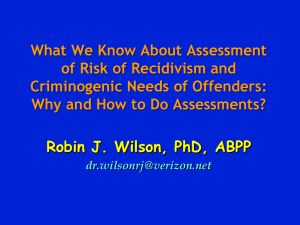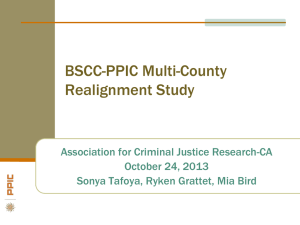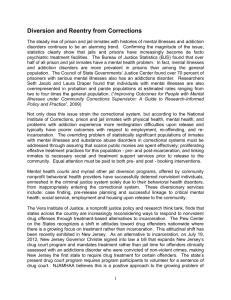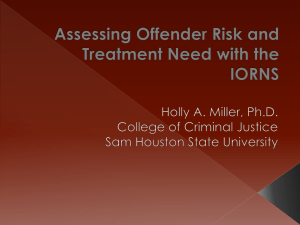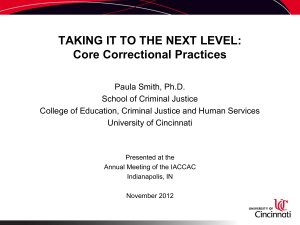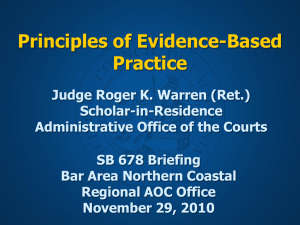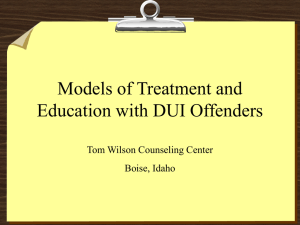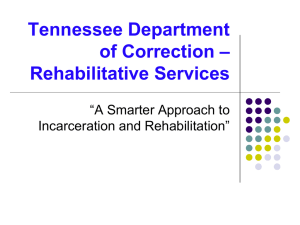Targeting Criminogenic Need - Missouri Juvenile Justice Association
advertisement
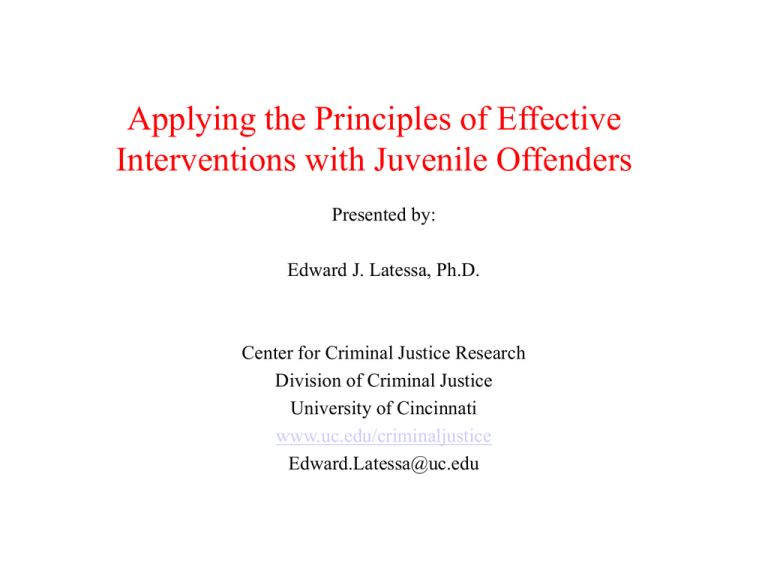
Applying the Principles of Effective Interventions with Juvenile Offenders Presented by: Edward J. Latessa, Ph.D. Center for Criminal Justice Research Division of Criminal Justice University of Cincinnati www.uc.edu/criminaljustice Edward.Latessa@uc.edu Evidence Based – What does it mean? There are different forms of evidence: – The lowest form is anecdotal evidence, but it makes us feel good – The highest form is empirical evidence – results from controlled studies, but it doesn’t make us feel good What does the Research tell us? There is often a Misapplication of Research: “XXX Study Says” - the problem is if you believe every study we wouldn’t eat anything (but we would drink a lot of red wine!) • Looking at one study can be a mistake • Need to examine a body of research • So, what does the body of knowledge about correctional interventions tell us? Prior Research Has Indicated…. ….that correctional services and interventions can be effective in reducing recidivism for offenders, however, not all programs are equally effective • The most effective programs are based on some principles of effective interventions • Risk (Who) • Need (What) • Treatment (How) • Program Integrity (How Well) Risk Principle • Provide more intense services to higher-risk offenders • Targeting lower risk offenders can lead to increases in recidivism rates The Risk Principle & Correctional Intervention Results from Meta Analysis Change In Recidivism Rates 25 20 19 15 10 5 -4 0 -5 High Risk Dowden & Andrews, 1999 Low Risk Average Effect Size for Juvenile Residential Facilities compared to Community Programs and Adherence to Risk Principle 0.16 0.14 Average Effect Size 0.12 0.1 0.08 0.06 0.04 0.02 0 -0.02 Adherence Non Adherence From: Lowenkamp, C., Latessa, E., & Lemke, R. (2006). Evaluation of Ohio's RECLAIM Funded Programs, Community Corrections Facilities, and DYS Facilities: FY 2002. University of Cincinnati, OH. Adherence=less than 25% low risk, Non=more than 25%. Follow-up was 2.1 years Need Principle • Target crime producing needs and risk factors • Not met as often as needed—many programs practice “correctional quackery” Definitely NOT Criminogenic Needs Need Principle By assessing and targeting criminogenic needs for change, agencies can reduce the probability of recidivism Criminogenic Non-Criminogenic • • • • • • • • • • Anti social attitudes Anti social friends Substance abuse Lack of empathy Impulsive behavior Anxiety Low self esteem Creative abilities Medical needs Physical conditioning Needs T argeted & Correlation with Effect Size for Youthful Offenders 0.4 0.3 Reduced Recidivism 0.2 0.1 0 Increased Recidivism -0.1 Bond Anti Social Peers Target Self-Esteem Vague Emotional Problems Respect Anti Social Thinking Physical Activity Criminogenic Needs Effect Size Fear of Punishment -0.2 -0.18 -0.12 -0.09 -0.06 -0.05 -0.03 0.36 Source: Dowden and Andrews, (1999). What Works in Young Offender Treatment: A Meta Analysis. Forum on Correctional Research. Correctional Services of Canada Targeting Criminogenic Need: Results from MetaAnalyses from Youthful Offenders 0.3 0.25 Reduction in Recidivism 0.2 0.15 0.1 0.05 Increase in Recidivism 0 Less than half criminogenic Fifty % or more criminogenic -0.05 Source: Dowden and Andrews (1999). What Works in Youthful Offender Treatment. Forum on Correctional Research.. Treatment Principle: Provide Behavioral Treatment Behavioral vs. NonBehavioral – Results from Meta Analysis 0.35 0.29 0.3 Reduced 0.25 Recidivism 0.2 0.15 0.1 0.07 0.05 0 Nonbehavioral (N=83) Behavioral (N=41) Andrews, D.A. 1994. An Overview of Treatment Effectiveness. Research and Clinical Principles, Department of Psychology, Carleton University. The N refers to the number of studies. Attributes of Behavioral Treatment • Focus on current factors that influence behavior • Action oriented • Offender behavior is appropriately reinforced Most Effective Behavioral Models • Structured social learning where new skills and behavioral are modeled • Cognitive behavioral approaches that target criminogenic risk factors • Family based approaches that train family on appropriate techniques Social Learning Refers to several processes through which individuals acquire attitudes, behavior, or knowledge from the persons around them. Both modeling and instrumental conditioning appear to play a role in such learning The Four Principles of Cognitive Intervention 1. Thinking affects behavior 2. Antisocial, distorted, unproductive irrational thinking causes antisocial and unproductive behavior 3. Thinking can be influenced 4. We can change how we feel and behave by changing what we think Relationship between Treatment Model and Treatment Effect for Residential Programs % Change in Recidivism 10 9 8 6 4 2 0 -2 -4 -6 -8 -10 Cognitive Behavioral Other -9 % Change in Recidivism Why practice? Relationship between Treatment Activities and Treatment Effect for Residential Programs 15 13 11 9 7 5 3 1 -1 -3 -5 13 6 2 -4 Practice Role Playing Yes No Of course some things don’t work Ineffective Approaches • Drug prevention classes focused on fear and other emotional appeals • Shaming offenders • Drug education programs • Non-directive, client centered approaches • Bibliotherapy • Freudian approaches • Talking cures • Self-Help programs • Vague unstructured rehabilitation programs • Medical model • Fostering self-regard (self-esteem) • “Punishing smarter” (boot camps, scared straight, etc.) Average Effects of Punishing Smarter Programs on Recidivism: Results from Meta Analyses 2 % Recidivism Reduced 0 -2 -4 % Recidivism Increased -6 -8 -10 -12 % Fines Drug Testing Restitution Elec Monit Scared Straight ISP Juv Boot Camps 0.4 0 -3 -3 -4 -6 -11 Sources: Gendreau et al (2000) The Effects of Community Sanctions and Incarceration on Recidivism, FORUM; Aos et al (1999) The Comparative Costs and Benefits of Programs to Reduce Crime, Washington State Institute for Public Policy. Fidelity Principle: Make Sure Programs Are Delivered With Fidelity and Integrity • Importance can’t be stressed enough • Can make or break a program • Can be measured • Most importantly it is dynamic and can be changed Effects of Quality Programs Delivery for Evidenced Based Programs for Youth Offenders 40 30 Reduced Recidivism 20 10 0 Increased Recidivism -10 -20 Functional Family Therapy Competently Delivered Not Competent 38 -16.7 Aggression Replacement Therapy 24 -10.4 Source: Outcome Evaluation of Washington State's Research-Based Programs for Juvenile Offenders. January 2004. Washington State Institute for Public Policy. Therapist Competency Ratings and Recidivism 35 12 Month Felony Recidivism 30 29 25 25 22 20 17 14 15 10 5 0 Not Competent Marginal Competent Highly Competent Control Group Source: Outcome Ev aluation of Washington State's Research-Based Programs for Juvenile Offenders . January 2004. Washington State Institute for Public Policy. Results—Impact of Program Factors Predicting Felony Adjudication Recidivism Measure Predicted Recidivism Rates 70 60 60 53 50 47 43 40 36 31 27 30 22 18 20 11 10 8 7 0 Low Program Score 0 Moderate Program Score 12 High Very High Program Score 24 Lessons Learned from the Research Who you put in a program is important – pay attention to risk What you target is important – pay attention to criminogenic needs How you target youth for change is important – use behavioral approaches Important Considerations o Assessment is the engine that drives effective programs helps you know who & what to target use valid third generation instruments Program Integrity make a difference Service delivery, disruption of delinquent networks, better training & supervision of staff, & QA are all important aspects of effective programs Don’t be afraid to evaluate what you do Many Programs Use the Christopher Columbus Style of Program Design WHEN HE SET OUT… He didn’t know where he was going. WHEN HE GOT THERE… He didn’t know where he was. WHEN HE GOT BACK… He didn’t know where he had been. Use Evidence Based Approaches and Design Programs Around the Empirical Research
